When a cat kneads with its hind legs, it is using an instinctive behavior rooted in its wild ancestors. Cats knead to mark their territory and show contentment. The motion of kneading helps them loosen up their muscles and prepare for a good nap. Kneading is a common feline behavior and often involves paw flexion and extension, and claw extension. Cats may also exhibit accompanying behaviors like purring and vocalizations during kneading. Kneading can be seen in both front and hind legs, with hind leg kneading sometimes referred to as the “milk tread.” Cats also engage in kneading as kittens to stimulate milk production from their mother. This behavior may continue into adulthood as a way to show comfort and contentment. While most cats knead with their front paws, some also incorporate their hind legs into the rhythmic motion, creating a unique variation.
Key Takeaways:
- Kneading with the hind legs is an instinctive behavior in cats that dates back to their wild ancestors.
- Cats knead to mark their territory, show contentment, and prepare for relaxation.
- Kneading can involve paw flexion, extension, and claw extension, and is often accompanied by purring and vocalizations.
- Kitten kneading stimulates milk production from their mother, and the behavior may continue into adulthood as a sign of comfort and contentment.
- While most cats knead with their front paws, some incorporate their hind legs into the motion, creating a unique variation.
Why Do Cats Knead with Their Back Legs?
Understanding the reasons behind a cat’s behavior can help us better connect with our feline friends. When it comes to kneading with their back legs, there are several theories that explain why cats engage in this unique behavior.
One theory suggests that kneading with the hind legs is a form of territorial behavior. By pressing down on surfaces, cats can transfer their scent from the scent glands in their paw pads, marking their territory and establishing ownership. This behavior is rooted in their wild instincts, as they would have used scent marking to communicate with other cats in the wild.
Another theory is that kneading with the hind legs helps cats loosen their muscle tissue before settling down for a nap. This motion can provide a pleasurable sensation to the cat, similar to how humans enjoy a good stretch. It may also help them release any pent-up energy and prepare their body for relaxation.
The exact reasons for why cats knead with their back legs may vary from cat to cat, but it is generally considered a normal behavior associated with comfort and relaxation.
| Theories | Reasons |
|---|---|
| Territorial Behavior | Marking territory by transferring scent |
| Preparation for Relaxation | Loosening muscle tissue and releasing energy |
Ultimately, the exact reasons for why cats knead with their back legs may vary from cat to cat. Some cats may knead solely for territorial purposes, while others may do it primarily as a way to relax and prepare for a nap. Regardless of the specific reasons, kneading with the back legs is generally considered a normal behavior associated with comfort and relaxation in cats.
Kneading vs. Stomping: Is There a Difference?
When it comes to cat behavior, kneading and stomping may appear similar, but there are distinct differences between the two actions. Kneading is a rhythmic motion of pushing and pulling against a soft surface, often accompanied by paw flexion and extension, and claw extension. It is a natural behavior for cats and is typically associated with contentment and relaxation. On the other hand, stomping involves a more intense and frantic motion, as if the cat is trying to beat or dig into something under the surface.
Stomping behavior in cats can be associated with aggression or territorial disputes, especially when accompanied by biting or aggression towards humans or other animals. It may be a way for cats to establish dominance or defend their territory. Observing the context in which the behavior occurs is crucial in determining whether it is kneading or stomping. Stomping behavior should not be ignored or dismissed, as it may indicate underlying aggression issues that need to be addressed.
To differentiate between kneading and stomping, it is important to pay attention to the intensity and purpose of the behavior. Kneading is a gentle, repetitive motion that cats use to mark their territory, show contentment, or prepare for relaxation. Stomping, on the other hand, is a more forceful and aggressive action that may be triggered by territorial disputes or aggressive tendencies. Understanding the distinction between these behaviors can help cat owners identify any potential aggression issues and take appropriate action to address them.
Understanding Cat Kneading Behavior
Cat kneading behavior is a fascinating aspect of feline behavior that can provide valuable insights into a cat’s emotions and needs. By observing a cat’s body posture during kneading, we can gain a deeper understanding of their comfort and contentment levels.
When a cat is kneading, they typically exhibit a relaxed body posture. Their muscles are loose, and their tail may wag gently. You may also notice their eyes narrowing slightly, indicating a sense of relaxation. Cats often knead with a rhythmic motion, flexing and extending their paws, which can be a sign of contentment and pleasure.
It’s important to note that while kneading is generally associated with positive emotions, it can also be triggered by stress or anxiety in some cats. If a cat’s body posture appears tense, with their ears flattened or their tail twitching rapidly, it may be a sign of discomfort or agitation. In such cases, it’s essential to identify the underlying cause of stress and provide appropriate support.
| Cat Body Posture | Description |
|---|---|
| Relaxed | Loose muscles, gentle tail wagging, narrowed eyes |
| Tense | Flattened ears, rapidly twitching tail |
“Understanding a cat’s body language can help us respond better to their needs and emotions. By paying attention to their body posture during kneading, we can ensure their comfort and well-being.”
Feline Aggression Triggers
While kneading is generally a benign behavior, there can be specific triggers that lead to aggression in some cats. It’s important to be aware of these triggers and take steps to prevent any potential harm. Common feline aggression triggers include:
- Threatened territory
- Fear or anxiety
- Previous traumatic experiences
- Social conflicts with other cats
By understanding these triggers, we can create a safe and secure environment for our cats, minimizing the risk of aggressive behavior. It’s crucial to provide adequate resources, such as separate feeding areas and litter boxes, to avoid territorial disputes. Additionally, seeking professional help from a veterinarian or animal behaviorist can offer valuable guidance in managing feline aggression.
By recognizing the body language signals and understanding the triggers of feline aggression, we can build a stronger bond with our cats and help them live happy, fulfilling lives.
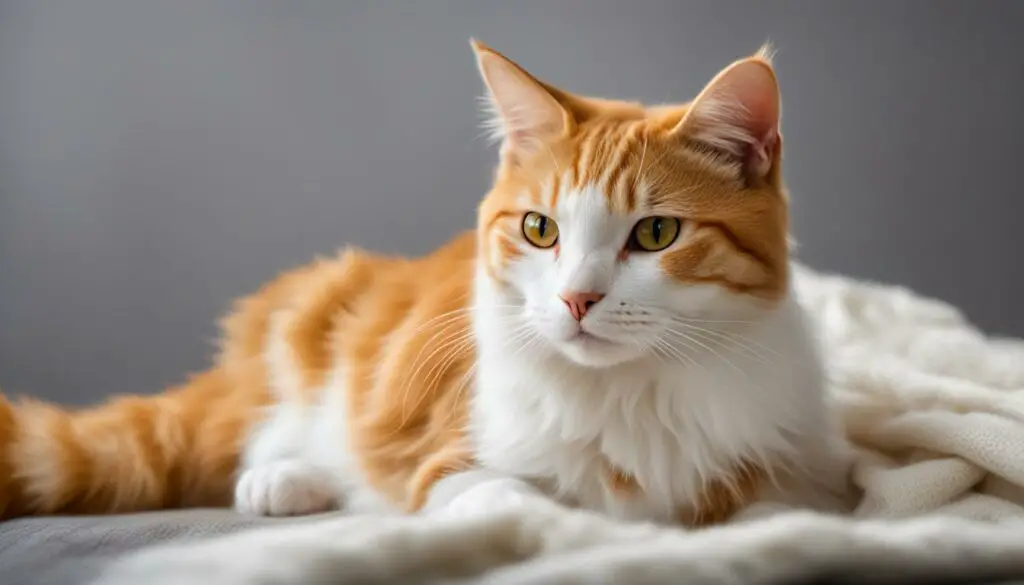
The Psychology Behind Cat Kneading
Cat kneading behavior has a psychological component that is influenced by their natural instincts and domestication. Cats knead to mark their territory and leave their scent on surfaces. This behavior is often accompanied by purring and other vocalizations, which are forms of communication. Understanding the psychology behind cat kneading can help in managing and training cats to reduce territorial aggression.
One important aspect of the psychology behind cat kneading is the need to establish their territory. By kneading and leaving their scent on surfaces, cats are asserting ownership and marking their territory. This behavior is rooted in their wild ancestors, who would scratch and mark their territory as a way to communicate with other cats.
“Cats knead to mark their territory and leave their scent on surfaces. This behavior is often accompanied by purring and other vocalizations, which are forms of communication.”
Another psychological factor behind cat kneading is the pleasurable sensation it provides. When cats knead, they engage in a rhythmic motion that helps them loosen their muscle tissue and prepare for relaxation. This motion can be pleasurable for cats, similar to how humans enjoy a massage or other forms of physical touch.
| Potential Causes of Cat Kneading | Psychological Factors |
|---|---|
| Marking territory | Establishing ownership and communication |
| Preparing for relaxation | Pleasurable sensation and muscle relaxation |
Understanding the psychological reasons behind cat kneading is essential for managing and training cats. By providing appropriate environmental enrichment, such as scratching posts and vertical spaces, cats can redirect their kneading behavior onto appropriate surfaces. Positive reinforcement training techniques can also be used to reinforce desired behaviors and discourage aggressive kneading.
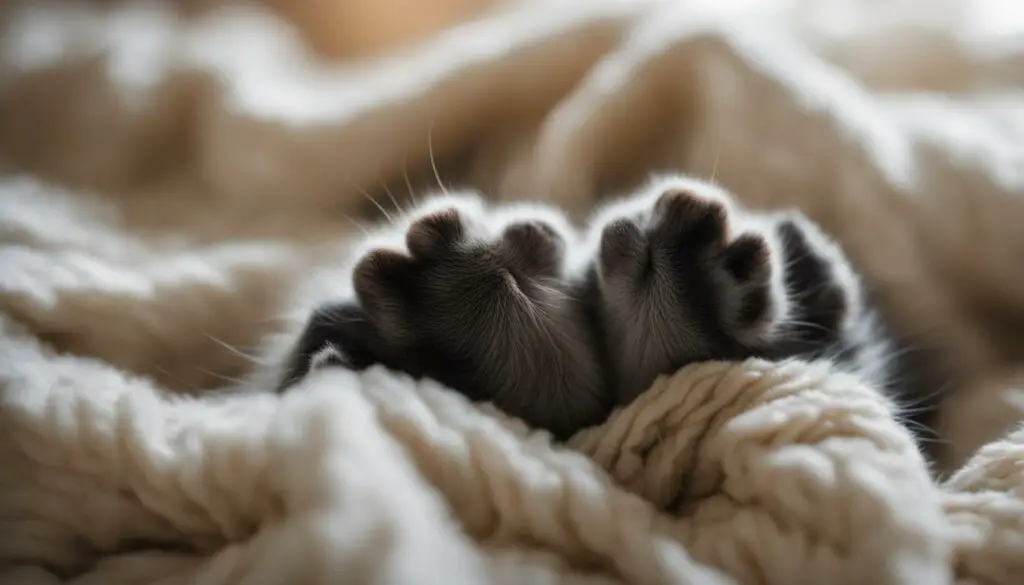
In summary, the psychology behind cat kneading is multifaceted, involving territorial marking and pleasurable sensations. By understanding these factors, cat owners can create a harmonious environment for their feline friends and promote positive behaviors.
The Connection Between Kneading and Play Behavior
Understanding the connection between kneading and play behavior in cats can provide valuable insights into their natural instincts and behaviors. The act of kneading, which involves rhythmic pushing and pulling with the paws, is often associated with the hunting behavior of kittens. When kittens knead their mother’s belly, they are stimulating milk production and developing their hunting skills. This instinct can carry over into adulthood, where kneading becomes a way for cats to express their playfulness and engage in their natural hunting behaviors.
Kneading is often accompanied by other playful actions, such as batting, pouncing, and chasing imaginary prey. These behaviors serve as an outlet for a cat’s energy and help them keep their hunting skills sharp. Engaging in play behavior is not only mentally stimulating for cats but also provides physical exercise, helping to keep them physically fit and mentally satisfied.
While kneading and play behavior are typically harmless and enjoyable, it is important to redirect these behaviors onto appropriate toys and surfaces. Providing interactive toys that simulate prey-like movements and encouraging play sessions can help fulfill a cat’s play instincts and prevent any aggressive or destructive behaviors.
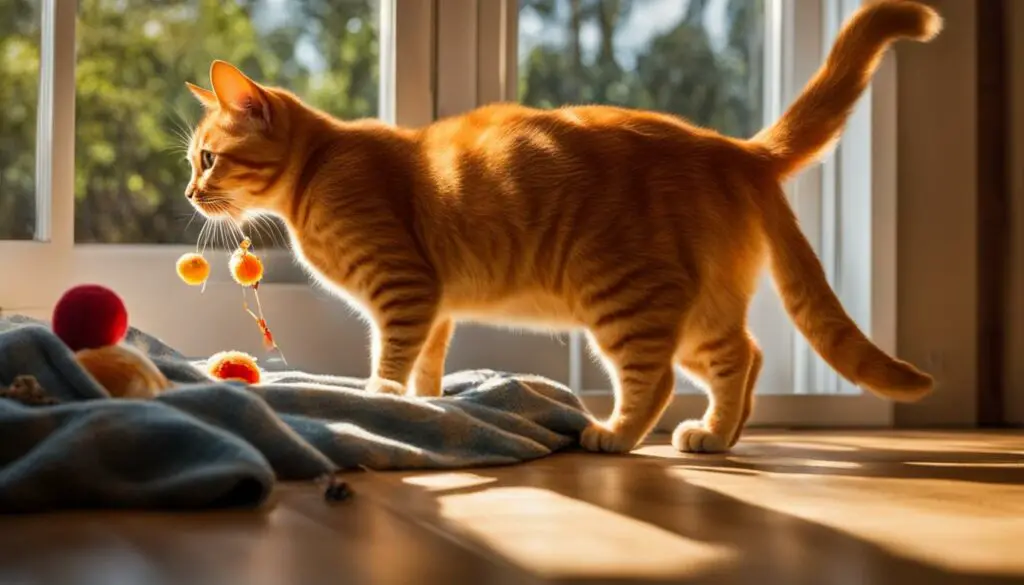
Overall, understanding the connection between kneading and play behavior in cats can help cat owners provide appropriate outlets for their cats’ natural instincts and promote a healthy and fulfilling lifestyle.
The Importance of Reading Cat Body Language
Understanding cat body language is essential for any cat owner or enthusiast. Cats communicate through a variety of body signals, including tail movements, vocalizations, and facial expressions. By paying close attention to these cues, we can better understand our feline friends and respond appropriately to their needs and emotions.
Cat tail movements are particularly informative when it comes to deciphering their body language. A relaxed, gently swaying tail generally indicates a content and calm cat. On the other hand, an erect tail held high and rigid may signal excitement or agitation. A puffed-up tail can be a sign of fear or aggression. By observing the position and movement of a cat’s tail, we can gauge their emotional state and adjust our interactions accordingly.
Feline vocalizations also provide valuable clues about a cat’s mood. Hissing and growling are defensive sounds that cats make when they feel threatened or fearful. Meowing is a form of communication that cats use to get our attention, express their needs, or simply engage in conversation. Purring, a familiar and soothing sound, is often associated with contentment and relaxation. By listening to these vocalizations, we can gain insights into how a cat is feeling and respond appropriately to their vocal cues.
| Body Signal | Meaning |
|---|---|
| Tail held high and rigid | Excitement or agitation |
| Puffed-up tail | Fear or aggression |
| Hissing and growling | Threatened or fearful |
| Meowing | Communication or attention-seeking |
| Purring | Contentment and relaxation |
Alongside tail movements and vocalizations, a cat’s facial expressions can also provide valuable insights into their emotions. Dilated pupils may indicate excitement or fear, while narrow or constricted pupils can signal aggression or stress. A relaxed, open-mouthed expression often reflects a state of contentment, while a tense or tight-lipped expression can suggest discomfort or unease. By paying attention to these subtle facial cues, we can better understand a cat’s emotional state and respond accordingly to provide a safe and nurturing environment.
The Importance of Recognizing Stress Signals and Behaviors in Cats
Cats can experience stress and anxiety, and it’s crucial for cat owners to be able to identify the signs and behaviors associated with these emotions. By recognizing and understanding these stress signals, we can create a safe and calm environment for our feline friends. Some common cat stress behaviors include changes in activity levels, excessive grooming, hiding, decreased appetite, aggression, or changes in litter box habits. These behaviors are often indicators that something is causing stress in your cat’s life.
Additionally, cat fear behaviors can also be signs of underlying anxiety or stress. These behaviors may include hiding, freezing, or excessive vigilance. It’s important to pay attention to these cues and provide your cat with a sense of security and comfort.
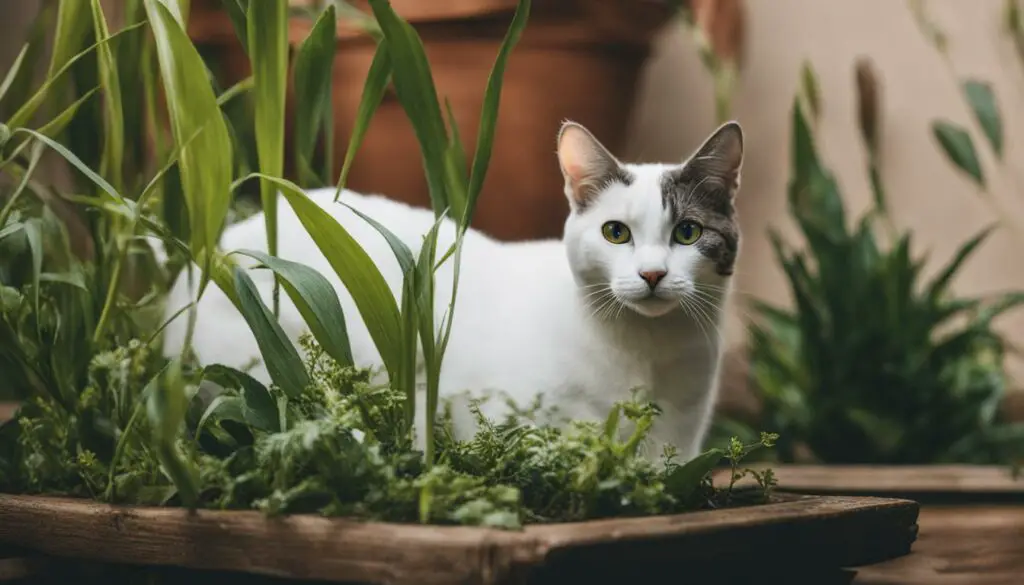
By recognizing and addressing these stress signals and behaviors, we can help our cats feel more relaxed and content. Providing a routine and plenty of hiding spots can give them a sense of control and security. Interactive play sessions and environmental enrichment, such as puzzle toys or scratching posts, can also help alleviate stress and anxiety. If needed, consult with a veterinarian or a professional animal behaviorist for additional guidance on managing stress in your cat.
Recognizing Signs of Pain or Leg Problems in Cats
When it comes to our feline friends, it’s important to pay attention to their body language and behavior to ensure their well-being. Cats are masters at hiding their pain, but there are some signs and signals that can indicate they may be experiencing leg problems or discomfort. By recognizing these signs, we can take the necessary steps to provide them with the care they need.
Cat body signals of pain or leg problems can include limping or favoring one leg, reluctance to jump or climb, decreased mobility, and changes in grooming habits. If you notice any of these signs, it’s important to consult with a veterinarian who can perform a thorough examination and provide a proper diagnosis. They may recommend imaging tests such as X-rays or ultrasounds to identify any injuries or underlying conditions.
Common causes of cat leg problems can include sprains, fractures, arthritis, or nerve damage. These conditions can cause acute or chronic pain and may require different treatment approaches. Treatment options can range from pain management medications to rehabilitation exercises or even surgery in severe cases. The goal is to address the underlying cause of the leg problem and alleviate the cat’s pain and discomfort.
Table: Common Signs of Cat Leg Problems
| Signs | Description |
|---|---|
| Limping | Walking with a noticeable limp, favoring one leg, or holding a leg up off the ground. |
| Reluctance to Jump or Climb | Avoiding activities that require jumping, such as getting on furniture or climbing stairs. |
| Decreased Mobility | Difficulty moving around or showing reduced range of motion in their legs. |
| Changes in Grooming Habits | Overgrooming a particular leg or avoiding grooming altogether due to pain or discomfort. |
If you suspect that your cat may be experiencing leg problems or pain, it’s essential to seek veterinary care promptly. Cats rely on their legs for mobility, balance, and overall well-being, so addressing any issues as early as possible can lead to better outcomes and improve their quality of life.

Understanding Feline Compulsive Disorders
Feline compulsive disorders are behavioral conditions characterized by repetitive and excessive behaviors that serve no apparent purpose. These behaviors can include excessive sucking and chewing, running and chasing, and self-directed aggression. Cats with compulsive disorders may engage in these behaviors for extended periods of time, often to the detriment of their physical and mental well-being.
The exact cause of feline compulsive disorders is not fully understood, but it is believed to be a combination of genetic, environmental, and psychological factors. These behaviors are thought to provide cats with a sense of comfort or control, but they can become excessive and detrimental if not addressed.
Managing feline compulsive disorders can be challenging, as it requires a multifaceted approach. Environmental enrichment, such as providing interactive toys and engaging in regular play sessions, can help redirect the cat’s energy and provide mental stimulation. Behavioral modification techniques, such as positive reinforcement training and redirecting the cat’s attention to more appropriate behaviors, may also be beneficial. In some cases, medication may be prescribed to help manage underlying anxiety or compulsive tendencies.
Common Feline Compulsive Behaviors
Excessive Sucking and Chewing:
- Cats may excessively suck on blankets, furniture, or their own bodies.
- This behavior can lead to hair loss, skin irritation, and potential ingestions of non-edible materials.
Running and Chasing:
- Cats may engage in frenetic running and chasing, often directed at imaginary objects.
- This behavior can be accompanied by vocalizations and intense bursts of energy.
Self-Directed Aggression:
- Cats may display aggressive behaviors towards themselves, such as biting or scratching their own bodies.
- This behavior can cause injury and may be indicative of underlying stress or anxiety.
It is important to consult with a veterinarian or animal behaviorist if your cat is exhibiting compulsive behaviors. They can provide guidance on how to manage and treat these behaviors effectively, improving your cat’s quality of life and overall well-being.
| Common Feline Compulsive Behaviors | Management Techniques |
|---|---|
| Excessive Sucking and Chewing | – Provide appropriate chew toys and redirect the cat’s attention. – Ensure an enriched environment with plenty of mental and physical stimulation. – Consult with a veterinarian to rule out any underlying medical conditions. |
| Running and Chasing | – Engage in regular interactive play sessions to redirect energy. – Provide environmental enrichment, such as interactive toys and scratching posts. – Consider using puzzle feeders or treat-dispensing toys to provide mental stimulation. |
| Self-Directed Aggression | – Avoid reinforcing aggressive behaviors and redirect the cat’s attention to more appropriate activities. – Provide a calm and structured environment with hiding spots and vertical spaces. – Consult with a veterinarian or animal behaviorist for behavior modification techniques and potential medication options. |
Managing Feline Psychogenic Alopecia
Feline psychogenic alopecia is a condition that manifests in excessive licking and overgrooming, often caused by stress behaviors and compulsive disorders. It is important to address the underlying causes of feline psychogenic alopecia to effectively manage the condition and promote healthier behavior in cats.
Stress is a common trigger for feline psychogenic alopecia, and identifying and reducing stressors in a cat’s environment can help alleviate the behavior. Creating a calm and enriched environment with plenty of hiding spots, vertical spaces, and interactive toys can provide mental stimulation and reduce anxiety. Regular play sessions and positive reinforcement can also help redirect the cat’s focus and energy away from excessive grooming.
In some cases, medication may be necessary to manage compulsive behaviors or underlying anxiety. Consultation with a veterinarian or a veterinary behaviorist can help determine the appropriate treatment plan for feline psychogenic alopecia. Additionally, behavioral therapy techniques, such as redirecting the cat’s attention to alternative activities or providing puzzle toys, can help distract from overgrooming tendencies.
It is important to provide consistent care and monitoring for cats with feline psychogenic alopecia to prevent the development of secondary skin infections or injuries. Regular veterinary check-ups can help ensure that any underlying medical conditions are addressed and managed appropriately. With a proactive and holistic approach, feline psychogenic alopecia can be effectively managed, promoting a healthier and happier life for cats.
Table: Common Management Strategies for Feline Psychogenic Alopecia
| Management Strategy | Description |
|---|---|
| Identifying and reducing stressors | Identify and address sources of stress or conflict in the cat’s environment. Create a calm and enriched environment with hiding spots, vertical spaces, and interactive toys. |
| Regular play sessions | Engage in regular interactive play sessions with the cat to redirect excessive grooming behaviors and provide mental stimulation. |
| Positive reinforcement | Use positive reinforcement techniques to reward desired behaviors and redirect attention away from overgrooming tendencies. |
| Medication | Consult a veterinarian or veterinary behaviorist to determine if medication is necessary to manage compulsive behaviors or underlying anxiety. |
| Behavioral therapy techniques | Implement behavioral therapy techniques such as redirecting attention to alternative activities or providing puzzle toys to distract from overgrooming tendencies. |
| Regular veterinary check-ups | Ensure regular veterinary check-ups to monitor for any underlying medical conditions and address them promptly. |
Feline Hyperesthesia: Exploring Rippling Skin Syndrome and Behavioral Causes
Feline hyperesthesia, also known as rippling skin syndrome or rolling skin syndrome, is a condition characterized by increased sensitivity to touch or scratching along the back. Cats with hyperesthesia may exhibit exaggerated responses such as muscle spasms, skin rippling, and vocalization. While the exact cause of hyperesthesia is not fully understood, it is believed to have underlying medical, neurological, or behavioral causes.
One possible behavioral cause of feline hyperesthesia is anxiety or stress. Cats experiencing high levels of stress may develop hyperesthesia as a coping mechanism. It is important to provide a calm and structured environment for these cats, avoiding stimuli that trigger the hyperesthesia response. Implementing behavioral techniques and environmental modifications can help reduce anxiety and manage the condition.
Another behavioral cause of feline hyperesthesia could be compulsive tendencies. Cats with compulsive disorders may exhibit repetitive behaviors, such as excessive grooming, that can trigger hyperesthesia. Along with behavioral therapy, environmental enrichment can help redirect the cat’s focus and energy towards more appropriate activities. Providing interactive toys and regular play sessions can also help fulfill their natural instincts and reduce compulsive behaviors.
It is essential to consult with a veterinarian to rule out any underlying medical or neurological causes of feline hyperesthesia. A comprehensive diagnostic workup may be needed to identify and address any contributing factors. In some cases, medications such as those used for seizure disorders or antidepressants may be prescribed to help manage the condition.
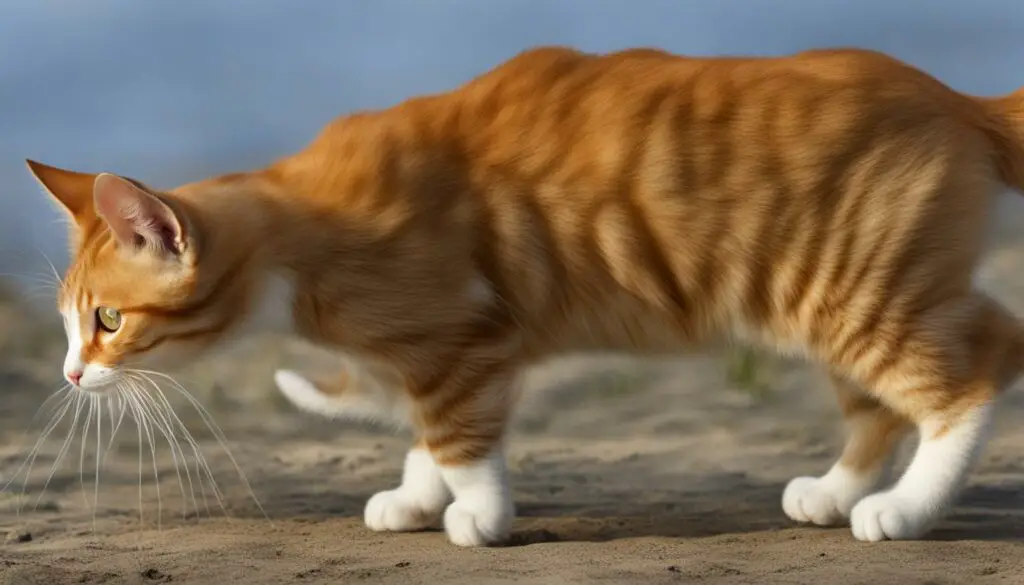
The Impact of Behavioral Causes on Feline Hyperesthesia
Understanding the behavioral causes of feline hyperesthesia is crucial in providing appropriate management and care for affected cats. By addressing anxiety, stress, and compulsive tendencies, cat owners can create a supportive environment that promotes their pet’s well-being. With the right combination of behavioral modifications, environmental enrichment, and potentially medication, cats with hyperesthesia can lead comfortable and fulfilling lives.
Coping with Tail Chasing and Tail Mutilation
Some cats may exhibit tail chasing or tail mutilation behaviors, which can be a result of play, anxiety, or compulsive tendencies. Tail chasing can become a self-injurious behavior that puts the cat at risk of injury or infection. Tail mutilation refers to the excessive chewing, biting, or licking of the tail, which can lead to hair loss, skin irritations, and open wounds.
Addressing these behaviors requires a comprehensive approach that involves behavioral therapy, environmental modifications, and, in some cases, medication. Behavioral therapy aims to redirect the cat’s focus and provide alternative outlets for their energy. Engaging the cat in interactive play sessions with toys that mimic prey can help redirect their attention and fulfill their hunting instincts. Environmental modifications, such as providing scratching posts, vertical spaces, and hiding spots, can help reduce anxiety and create a more stimulating environment.
Additionally, behavioral therapy may involve discouraging the behavior through techniques like remote deterrent devices or interrupting the behavior with a loud noise. Positive reinforcement for desirable behaviors, such as calm and relaxed behavior, can also be effective in addressing tail chasing and mutilation. It’s important to consult with a veterinarian or a professional animal behaviorist to develop an appropriate and tailored behavior modification plan for the cat’s specific needs.
| Behaviors | Coping Strategies |
|---|---|
| Tail Chasing |
|
| Tail Mutilation |
|
It’s important to note that tail chasing and tail mutilation can be symptoms of underlying medical conditions or pain. Therefore, it’s crucial to rule out any medical causes before addressing these behaviors solely as behavioral issues. Consulting with a veterinarian will help determine if there are any underlying medical concerns that need to be addressed alongside the behavioral modifications.
By implementing a holistic approach to address tail chasing and tail mutilation behaviors, cat owners can help their feline companions find healthier ways to cope with their instincts, reduce anxiety, and promote overall well-being.
Promoting Positive Behavioral Changes
When it comes to promoting positive behavior in cats, positive reinforcement, behavioral training, and environmental enrichment are key. By using positive reinforcement techniques, such as treats, praise, and rewards, you can reinforce desired behaviors and encourage your cat to engage in positive actions. This can include behaviors like using a scratching post, using the litter box, or playing with appropriate toys. Positive reinforcement helps create a trusting and rewarding relationship with your feline friend.
Behavioral training is another important aspect of promoting positive behavior in cats. By using consistent and gentle training methods, you can teach your cat certain behaviors and discourage unwanted ones. For example, you can train your cat to come when called, to stay off specific furniture, or to walk on a leash. Training sessions should be short and frequent, with plenty of rewards and positive reinforcement.
Environmental enrichment plays a crucial role in keeping your cat mentally stimulated and content. Providing a variety of toys, scratching posts, and interactive games can help satisfy your cat’s natural instincts and reduce boredom or destructive behavior. Additionally, offering vertical spaces, such as cat trees or shelves, allows your cat to climb and explore their environment, promoting physical exercise and mental stimulation.
| Positive Reinforcement | Behavioral Training | Environmental Enrichment |
|---|---|---|
|
|
|
By incorporating positive reinforcement, behavioral training, and environmental enrichment into your cat’s daily routine, you can create a harmonious and positive environment that promotes good behavior and enhances your cat’s overall well-being.
Conclusion
In conclusion, understanding cat stomping back legs, also known as kneading, involves recognizing the instinctual behaviors and motivations behind this common feline behavior. Cats knead to mark their territory, show contentment, and prepare for relaxation. It is a combination of instinctual and learned behaviors that can be observed in various situations.
By understanding the psychology behind cat kneading, recognizing stress signals, and addressing any underlying medical problems or compulsive tendencies, cat owners can promote a healthy and positive behavior in their feline friends. It is important to create a calm and enriched environment for cats, providing appropriate outlets for their predatory instincts and natural hunting behaviors.
Observing feline leg movements and body language, cat owners can better understand their pets and respond appropriately. By implementing positive reinforcement, behavioral training, and environmental enrichment, cat owners can promote positive behavioral changes in their cats and minimize territorial disputes or aggressive tendencies.
In summary, cat stomping back legs is a fascinating behavior that reflects a cat’s natural instincts, comfort, and territorial marking. By considering the unique characteristics and needs of cats, we can create a harmonious and fulfilling environment for our feline companions.
FAQ
Why do cats knead with their back legs?
Cats knead with their back legs as a way to mark their territory, show contentment, or prepare for relaxation.
Is there a difference between kneading and stomping?
Yes, kneading is a rhythmic motion of pushing and pulling against a soft surface, while stomping is a more intense and frantic motion associated with aggression or territorial disputes.
How can I understand cat kneading behavior?
Understanding cat body posture, recognizing aggression triggers, and identifying the causes of aggression are important in deciphering cat kneading behavior.
What is the psychology behind cat kneading?
Cat kneading behavior is influenced by natural instincts, territorial marking, and communication. Managing territorial aggression and providing environmental enrichment are key in addressing this behavior.
Is there a connection between kneading and play behavior in cats?
Yes, kittens often knead during play as a way to express their hunting instincts. Redirecting this behavior onto appropriate toys and discouraging aggression towards humans or animals is important.
How can I read my cat’s body language?
Cats communicate through tail movements, vocalizations, and facial expressions. Paying attention to these cues helps in understanding their emotions and intentions.
How can I recognize stress signals and behaviors in my cat?
Changes in activity levels, excessive grooming, hiding, aggression, and changes in litter box habits can indicate stress or anxiety in cats.
What are the signs of pain or leg problems in cats?
Limping, reluctance to jump or climb, decreased mobility, and changes in grooming habits can indicate pain or leg problems in cats.
What are feline compulsive disorders?
Feline compulsive disorders manifest in excessive behaviors like sucking and chewing, running and chasing, self-directed aggression, overgrooming, and tail mutilation.
How can I manage feline psychogenic alopecia?
Medical treatment to address underlying skin disorders or allergies, behavioral management techniques, and identification of stress sources are key in managing feline psychogenic alopecia.
What is feline hyperesthesia?
Feline hyperesthesia is a condition characterized by increased sensitivity to touch or scratching along the back, resulting in exaggerated responses like skin rippling, muscle spasms, and vocalization.
How can I cope with tail chasing and tail mutilation in cats?
Behavioral therapy, environmental modifications, and providing alternative outlets for play can help manage tail chasing and tail mutilation behaviors in cats.
How can I promote positive behavioral changes in my cat?
Using positive reinforcement, behavioral training, and environmental enrichment are key in promoting positive behavioral changes in cats.
Source Links
- https://petsical.com/cat-kneading-with-hind-legs/
- https://www.catforum.com/threads/stomping-cat.71659/
- https://vcahospitals.com/know-your-pet/cat-behavior-problems-compulsive-disorders-in-cats